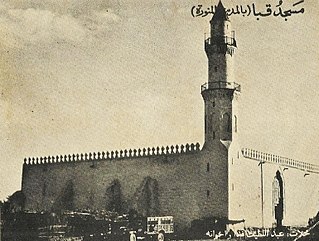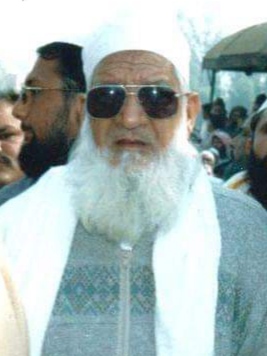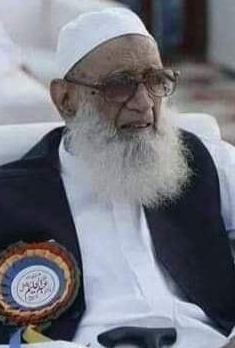
The Quba Mosque is a mosque located in Medina, in the Hejaz region of Saudi Arabia, built in the lifetime of the Islamic prophet Muhammad in the 7th century C.E. It is thought to be the first mosque in the world, built on the first day of Muhammad's emigration to Medina. Its first stone is said to have been laid by the prophet, and the structure completed by his companions.

A qalam is a type of reed pen. It is made from a cut, dried reed, and used for Islamic calligraphy. The pen is seen as an important symbol of wisdom in Islam, and references the emphasis on knowledge and education within the Islamic tradition.

Nastaliq, also romanized as Nastaʿlīq or Nastaleeq, is one of the main calligraphic hands used to write the Perso-Arabic script and it is used for some Indo-Iranian languages, predominantly Classical Persian, Kashmiri, Punjabi (Shahmukhi) and Urdu. It is often used also for Ottoman Turkish poetry, but rarely for Arabic. Nastaliq developed in Iran from naskh beginning in the 13th century and remains widely used in Iran, Afghanistan, Pakistan, and other countries for written poetry and as a form of art.

Islamic calligraphy is the artistic practice of handwriting and calligraphy, in the languages which use Arabic alphabet or the alphabets derived from it. It includes Arabic, Persian, Ottoman, and Urdu calligraphy. It is known in Arabic as khatt Arabi, which translates into Arabic line, design, or construction.

A dargah is a shrine or tomb built over the grave of a revered religious figure, often a Sufi saint or dervish. Sufis often visit the shrine for ziyarat, a term associated with religious visitation and pilgrimages. Dargahs are often associated with Sufi eating and meeting rooms and hostels, called khanqah or hospices. They usually include a mosque, meeting rooms, Islamic religious schools (madrassas), residences for a teacher or caretaker, hospitals, and other buildings for community purposes.
Al-Muʼminun is the 23rd chapter (sūrah) of the Qur'an with 118 verses (āyāt). Regarding the timing and contextual background of the supposed revelation, it is an earlier "Meccan surah", which means it is believed to have been revealed before the migration of the Islamic prophet Muhammad and his followers from Mecca to Medina (Hijra).
Muhaqqaq is one of the main six types of calligraphic script in Arabic. The Arabic word muḥaqqaq (محقَّق) means "consummate" or "clear", and originally was used to denote any accomplished piece of calligraphy.

Sheikh Hamdullah (1436–1520), born in Amasya, Ottoman Empire, was a master of Islamic calligraphy.

Syed Sadequain Ahmed Naqvi, and often referred to as Sadequain Naqqash, was a historical Pakistani artist and poet best known for his skills as a calligrapher and a painter. He is considered one of the finest painters and calligraphers Pakistan has ever produced, having painted around 15000 paintings. He is also recognised as the only artist in Pakistan to have received all four civilian awards such as the Nishan-i-Imtiaz, Sitara-i-Imtiaz, Tamgha-i-Imtiaz, and Pride of Performance.

In some forms of Islamic art, aniconism (the avoidance of images of sentient beings) stems in part from the prohibition of idolatry and in part from the belief that the creation of living forms is God's prerogative.

The Linden Museum is an ethnological museum located in Stuttgart, Germany. The museum features cultural artifacts from around the world, including South and Southeast Asia, Africa, the Islamic world from the Near East to Pakistan, China and Japan, and artifacts from North and Latin America and Oceania.
Mahmood Ahmad Ghazi was a Pakistani jurist and scholar of Islamic Studies, shariah and fiqh. He was a professor at the International Islamic University, Islamabad, judge at the Federal Shariat Court and Federal Minister for Religious Affairs in Pakistan. He completed his dars-e-nizami at the age of 16 and later obtained a PhD in Islamic Studies from Punjab University. He was fluent in Urdu, English, Arabic, Persian, Turkish and French. He authored numerous works in Urdu and English, and translated Persian poetry Payam-e-Mashriq of Muhammad Iqbal into Arabic.

The term ḥilya denotes both a visual form in Ottoman art and a religious genre of Ottoman-Arabic literature each dealing with the physical description of Muhammad. Hilya means "ornament". They originate with the discipline of shama'il, the study of Muhammad's appearance and character, based on hadith accounts, most notably al-Tirmidhi's Shama'il al-Muhammadiyya "The Sublime Characteristics of Muhammad". In Ottoman-era folk Islam, there was a belief that reading and possessing Muhammad's description protects the person from trouble in this world and the next, it became customary to carry such descriptions, rendered in fine calligraphy and illuminated, as amulets. In 17th-century Ottoman Turkey, ḥilān developed into an art form with a standard layout, often framed and used as a wall decoration. Later ḥilān were written for the four Rashid caliphs, the Companions of the Prophet, Muhammad's grandchildren Hasan and Husayn, and walis or saints.
Quranism is an Islamic movement that holds the belief that the Quran is the only valid source of religious belief, guidance, and law in Islam. Quranists believe that the Quran is clear, complete, and that it can be fully understood without recourse to the hadith and sunnah. Therefore, they use the Quran itself to interpret the Quran, an exegetical principle known as tafsir al-Qur'an bi al-Qur'an.
Lulwah Al-Homoud is a Saudi Arabian artist, calligrapher, and curator. She lives in the United Kingdom.

Nassar Mansour, , is an artist, calligrapher, academic and designer in the field of Islamic Arts, specializing in Islamic Calligraphy. He is considered to be one of the most accomplished contemporary Arab calligraphers today.

Sayed Nafees al-Hussaini was a calligrapher, Islamic scholar, poet, and spiritual figure. He was also blessed with calligraphy at one of the doors of the Masjid Al Haram in Makkah.
Muhammad Junagarhi (1890–1941) was an Indian Islamic scholar who co-founded and served as the president of the All-India Ahl-i Hadith Conference. He translated Ibn Qayyim's I'laam ul Muwaqqi'een 'an Rabb il 'Aalameen and Ibn Kathir's exegesis of the Quran into Urdu language.

Abdul Halim Chishti Nomani was a Pakistani Islamic scholar, librarian, writer and the first PhD in library sciences in Pakistan. He was a disciple of Hussain Ahmad Madani. He was head of the Department of Hadith Studies at Jamia Uloom Islamia and the younger brother of Abdul Rasheed Naumani.
Calligraphy in Azerbaijani culture is the role played by calligraphy in Azerbaijani literature and visual arts. In the Middle Ages, various examples of calligraphy were used in the writing of Azerbaijani manuscripts, and scientific works were written in the naskh line. In the 19th century, the works "Inshai-Mirza Kazim", "Majmaul-khosh Khatih" by Abdulqani Khalisagarizade Nukhavi and "Khatti-taliq va nastalig" by Abdussalam Akhundzadeh were written. Although calligraphy declined in Azerbaijan during the Soviet era, it is still used in modern times.












